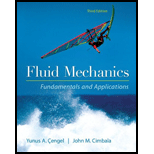
(a)
The temperature that a stationary probe inserted into the duct will read for the given velocity.
Answer to Problem 5P
The temperature that a stationary probe inserted into the duct will read for the given velocity is
Explanation of Solution
Given information:
The temperature of air is
Expression for the stagnation temperature
Here, the stagnation temperature of air is
Calculation:
The specific heat for air is
Substitute
Conclusion:
The temperature that a stationary probe inserted into the duct will read for the given velocity is
(b)
The temperature that a stationary probe inserted into the duct will read for the given velocity.
The temperature that a stationary probe inserted into the duct will read for the given velocity is
Given information:
The temperature of air is
Calculation:
Substitute
Conclusion:
The temperature that a stationary probe inserted into the duct will read for the given velocity is
(c)
The temperature that a stationary probe inserted into the duct will read for the given velocity.
The temperature that a stationary probe inserted into the duct will read for the given velocity is
Given information:
The temperature of air is
Calculation:
Substitute
Conclusion:
The temperature that a stationary probe inserted into the duct will read for the given velocity is
(d)
The temperature that a stationary probe inserted into the duct will read for the given velocity.
The temperature that a stationary probe inserted into the duct will read for the given velocity is
Given information:
The temperature of air is
Calculation:
Substitute
Conclusion:
The temperature that a stationary probe inserted into the duct will read for the given velocity is
(b)
The temperature that a stationary probe inserted into the duct will read for the given velocity.
Answer to Problem 5P
The temperature that a stationary probe inserted into the duct will read for the given velocity is
Explanation of Solution
Given information:
The temperature of air is
Calculation:
Substitute
Conclusion:
The temperature that a stationary probe inserted into the duct will read for the given velocity is
(c)
The temperature that a stationary probe inserted into the duct will read for the given velocity.
Answer to Problem 5P
The temperature that a stationary probe inserted into the duct will read for the given velocity is
Explanation of Solution
Given information:
The temperature of air is
Calculation:
Substitute
Conclusion:
The temperature that a stationary probe inserted into the duct will read for the given velocity is
(d)
The temperature that a stationary probe inserted into the duct will read for the given velocity.
Answer to Problem 5P
The temperature that a stationary probe inserted into the duct will read for the given velocity is
Explanation of Solution
Given information:
The temperature of air is
Calculation:
Substitute
Conclusion:
The temperature that a stationary probe inserted into the duct will read for the given velocity is
Want to see more full solutions like this?
Chapter 12 Solutions
Fluid Mechanics Fundamentals And Applications
- 35. a. Determine B. b. Determine side b. c. Determine side c. 5.330 in.- ZB 73°30'arrow_forwardConsider a 12 cm internal diameter, 14 m long circular duct whose interior surface is wet. The duct is to be dried by forcing dry air at 1 atm and 15 degrees C throught it at an average velocity of 3m/s. The duct passes through a chilled roo, and it remains at an average temp of 15 degrees C at all time. Determine the mass transfer coeeficient in the duct.arrow_forwardnote n=number of link(dont include the ground link (fixed))arrow_forward
- a) Determine state of stress at all points (a, b and c). These points are located on the exteriorsurface of the beam. Point a is located along the centreline of the beam, point b is 15mmfrom the centreline and point c is located on the edge of the beam. Present yourresults in a table and ensure that your sign convention is clearly shownb) Construct Mohrs circle at this point andcalculate the principal stresses and maximum in‐plane shear stress (τmax) at pointc. sketch the resulting state of stress at this point clearly indicating themagnitude of the stresses and any angles associated with the state of stress (principal ormaximum in‐plane shear).arrow_forwardparts e,f,garrow_forwardFigure 9-6 9-49 An aluminum alloy plate with dimensions 20 cm x 10 cm × 2 cm needs to be cast with a secondary dendrite arm spacing of 10-2 cm (refer to Figure 9-6). What mold constant B is required (assume n = 2 )? Secondary dendrite arm spacing (cm) - 10-1 10-2 10-3 10 41 0.1 1 Copper Zinc alloys Aluminum alloys 10 100 1,000 10,000 100,000 Solidification time (s)arrow_forward
 Refrigeration and Air Conditioning Technology (Mi...Mechanical EngineeringISBN:9781305578296Author:John Tomczyk, Eugene Silberstein, Bill Whitman, Bill JohnsonPublisher:Cengage Learning
Refrigeration and Air Conditioning Technology (Mi...Mechanical EngineeringISBN:9781305578296Author:John Tomczyk, Eugene Silberstein, Bill Whitman, Bill JohnsonPublisher:Cengage Learning Principles of Heat Transfer (Activate Learning wi...Mechanical EngineeringISBN:9781305387102Author:Kreith, Frank; Manglik, Raj M.Publisher:Cengage Learning
Principles of Heat Transfer (Activate Learning wi...Mechanical EngineeringISBN:9781305387102Author:Kreith, Frank; Manglik, Raj M.Publisher:Cengage Learning

